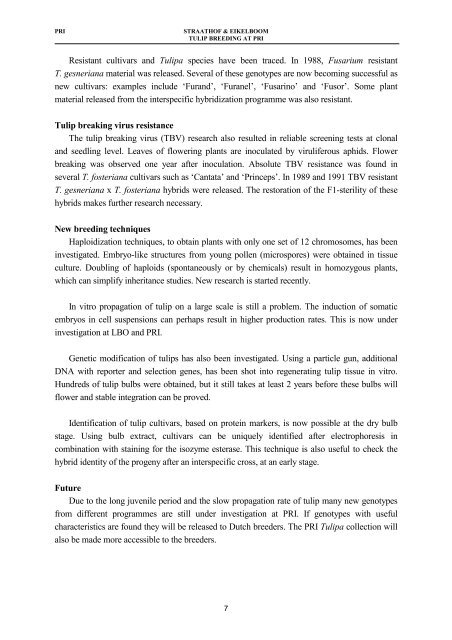Tulip breeding at PRI - The Lilium information page
Tulip breeding at PRI - The Lilium information page
Tulip breeding at PRI - The Lilium information page
You also want an ePaper? Increase the reach of your titles
YUMPU automatically turns print PDFs into web optimized ePapers that Google loves.
<strong>PRI</strong><br />
STRAATHOF & EIKELBOOM<br />
TULIP BREEDING AT <strong>PRI</strong><br />
Resistant cultivars and <strong>Tulip</strong>a species have been traced. In 1988, Fusarium resistant<br />
T. gesneriana m<strong>at</strong>erial was released. Several of these genotypes are now becoming successful as<br />
new cultivars: examples include ‘Furand’, ‘Furanel’, ‘Fusarino’ and ‘Fusor’. Some plant<br />
m<strong>at</strong>erial released from the interspecific hybridiz<strong>at</strong>ion programme was also resistant.<br />
<strong>Tulip</strong> breaking virus resistance<br />
<strong>The</strong> tulip breaking virus (TBV) research also resulted in reliable screening tests <strong>at</strong> clonal<br />
and seedling level. Leaves of flowering plants are inocul<strong>at</strong>ed by viruliferous aphids. Flower<br />
breaking was observed one year after inocul<strong>at</strong>ion. Absolute TBV resistance was found in<br />
several T. fosteriana cultivars such as ‘Cant<strong>at</strong>a’ and ‘Princeps’. In 1989 and 1991 TBV resistant<br />
T. gesneriana x T. fosteriana hybrids were released. <strong>The</strong> restor<strong>at</strong>ion of the F1-sterility of these<br />
hybrids makes further research necessary.<br />
New <strong>breeding</strong> techniques<br />
Haploidiz<strong>at</strong>ion techniques, to obtain plants with only one set of 12 chromosomes, has been<br />
investig<strong>at</strong>ed. Embryo-like structures from young pollen (microspores) were obtained in tissue<br />
culture. Doubling of haploids (spontaneously or by chemicals) result in homozygous plants,<br />
which can simplify inheritance studies. New research is started recently.<br />
In vitro propag<strong>at</strong>ion of tulip on a large scale is still a problem. <strong>The</strong> induction of som<strong>at</strong>ic<br />
embryos in cell suspensions can perhaps result in higher production r<strong>at</strong>es. This is now under<br />
investig<strong>at</strong>ion <strong>at</strong> LBO and <strong>PRI</strong>.<br />
Genetic modific<strong>at</strong>ion of tulips has also been investig<strong>at</strong>ed. Using a particle gun, additional<br />
DNA with reporter and selection genes, has been shot into regener<strong>at</strong>ing tulip tissue in vitro.<br />
Hundreds of tulip bulbs were obtained, but it still takes <strong>at</strong> least 2 years before these bulbs will<br />
flower and stable integr<strong>at</strong>ion can be proved.<br />
Identific<strong>at</strong>ion of tulip cultivars, based on protein markers, is now possible <strong>at</strong> the dry bulb<br />
stage. Using bulb extract, cultivars can be uniquely identified after electrophoresis in<br />
combin<strong>at</strong>ion with staining for the isozyme esterase. This technique is also useful to check the<br />
hybrid identity of the progeny after an interspecific cross, <strong>at</strong> an early stage.<br />
Future<br />
Due to the long juvenile period and the slow propag<strong>at</strong>ion r<strong>at</strong>e of tulip many new genotypes<br />
from different programmes are still under investig<strong>at</strong>ion <strong>at</strong> <strong>PRI</strong>. If genotypes with useful<br />
characteristics are found they will be released to Dutch breeders. <strong>The</strong> <strong>PRI</strong> <strong>Tulip</strong>a collection will<br />
also be made more accessible to the breeders.<br />
7














